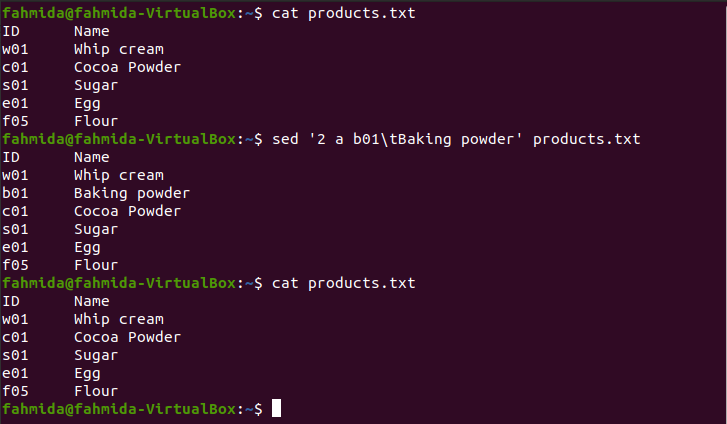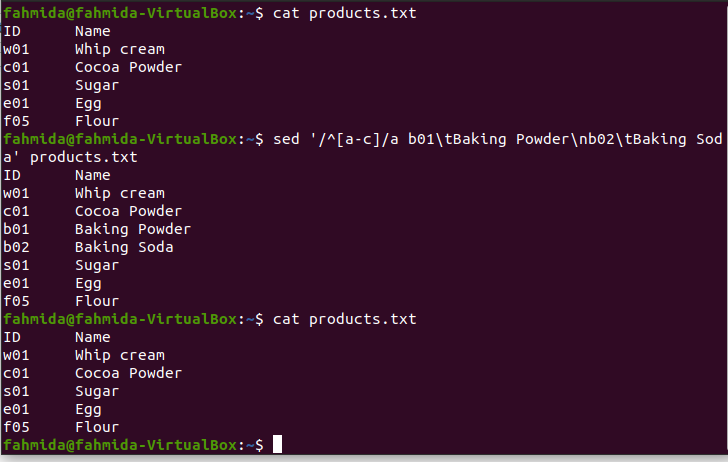One of the useful and powerful commands of Linux is the “sed” command. This command is used to perform different types of tasks in Linux, such as insert, update, and delete a particular text or line based on the match. You can insert a text in a string or a file in different ways by using the “sed” command.
How to insert a line after finding a match in a string or a line is shown in this tutorial.
Insert a line in the String
A new line can be inserted after any string value using the “sed” command if the pattern defined in the command matches with any part of the string value.
The following example shows how a new line can be added after a string value if a particular string exists anywhere in the string value.
Example-1: Insert a line in a string after finding a match
The following command will search “inng” in the string, “I like programming”, and a line of text, “Do you like programming?” will be inserted after the string if the searching string exists.
Here, the “&” character is used to insert the line after the string.
The following output shows that “inng” does not exist in the string and no line is inserted after the string.
The following command will search “ing.” in the string, “I like programming” and it exists in the string.
The following output shows that the new line is added after the string.
Insert a line in a File
There are two ways to insert a line after a match is found in a file that is mentioned below. When the “sed” command is used without the “-i option”, then the content of the file will remain unchanged, and the output will show the file content with the inserted newline. You have to use the “-i” option with the “sed” command to insert the new line permanently in the file if the matching pattern exists in the file.
A. Using “a” in the “sed” command
The “a” can be used in the search pattern of the “sed” to append one or more lines in a file after the line where the searching pattern matches or after a particular line number.
B. Using “i” in the “sed” command
The “i” can be used in the search pattern of the “sed” command to insert one or more lines in a file before the line where the searching pattern matches.
Insert line(s) in a file based on the pattern:
Create a tab-delimited text file named products.txt with the following content to show the uses of the above flag in the “sed” command.
products.txt
01 Whip cream
02 Cocoa Powder
03 Sugar
04 Egg
05 Flour
Example-2: Insert a line after a particular line number using the “a”
The following commands show how a new line can be added, after a particular line number of the products.txt file, based on the pattern used in the “sed” command.
Here, the first command will show the existing content of the file. The “sed” command will append the text, “b01 Baking powder”, after the first two lines of the file. The last command is used to check that the file content is changed or not.
$ sed '2 a b01\tBaking powder' products.txt
$ cat products.txt
The following output will appear after running the above command.
Example-3: Insert a line after the last line using the “a”
The following command shows the way to append a new line after the last line of the file. The first and last command shows the existing content of the file before and after executing the “sed” command. The “$” symbol is used in the pattern of the “sed” command to mention the last line of the file.
$ sed '$ a b01\tBaking powder' products.txt
$ cat products.txt
The following output will appear after running the above command.
Example-4: Insert a line anywhere in the file after matching a pattern using the “a”
The following “sed” command shows how a new line can be added anywhere in the file based on the matching pattern. The pattern used in the “sed” command will search any line starting with “s01”, and add the new string after it. The fourth line of the file starts with “s01”, and the new line will be inserted after that line.
$ sed '/^s01.*/a b01\tBaking Powder' products.txt
$ cat products.txt
The following output will appear after running the command.
The following “sed” command will search any line that ends with “Powder” and insert the new line after it. The third line of the file ends with “Powder”. So, the new line will be inserted after that line.
$ sed '/Powder$/a b01\tBaking Powder' products.txt
$ cat products.txt
The following output will appear after running the above commands.
Example-5: Insert multiple lines after the matching pattern using “a”
The following “sed” command shows the way to add multiple lines inside the content of a file based on the matching pattern.
Here, two lines will be added after the third line, according to the pattern.
$ sed '/^[a-c]/a b01\tBaking Powder\nb02\tBaking Soda' products.txt
$ cat products.txt
The following output will appear after running the above commands.
Example-6: Insert a line after matching a pattern using the “I”
$ sed '/cream/i b01\tBaking Powder' products.txt
$ cat products.txt
The following output will appear after running the above commands.
Example-7: Insert a line permanently after the matching pattern using the “-i” option
The following “sed” command shows how to change the content of the file permanently. The “i” option is used with the “sed” command to insert a new line in the file based on the pattern.
$ sed -i '/e$/a g01\tGhee' products.txt
$ cat products.txt
The following output will appear after running the above commands.
Conclusion:
The ways of inserting two or more lines in a file by using the “sed” command with pattern have been shown in this tutorial to help the reader apply this command for inserting lines in the temporarily or permanently based on the pattern.









